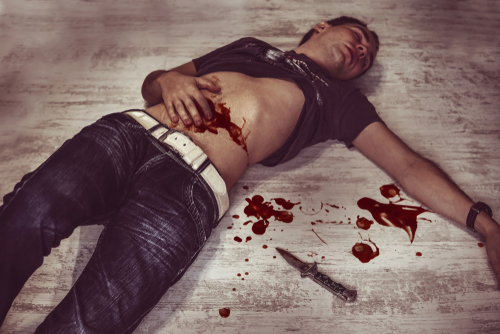When dealing with any sort of victim of a knife attack, your safety must come first. There is no point seeing someone get stabbed, immediately running over to help them and then getting stabbed yourself as well. So, always make sure that the assailant has left the area before you approach the patient. If you are in any doubt, stay away from the area and call the Emergency Services to make sure they are on their way.
Things to Look For
The next thing to look at is signs and symptoms. What can you see? Where is the wound? Is there more than one wound? What does the patient look like? How is the patient breathing? What position are you in? Is the wound gushing blood or is the wound sealed? How much blood has been lost? How severe is it? Where is the knife? All of this is vital information that you should take note of in the first few seconds of arrival. The knife may have hit important organs behind that knife and you need to know what potentially is damaged.
Another important one is, was it a male or a female that stabbed the person? Women tend to stab downwards and men tend to stab upwards. This is just a freak of nature but it does tend to be a fact. Men tend to stab with more force than women as well, so it tends to penetrate deeper. These are all “tends” so be aware that this will not always be the case. Always check the body for more than one stab wound. Were they stabbed in the back and they are lying on the back and you have missed it?
Knowing basic anatomy of some of the important organ systems in the human body could help you with what treatment you provide. Follow the links to read more about:
 Knife Wound First Aid
Knife Wound First Aid
It is imperative to never pull any object that is penetrating the body out of the body. There are two main reasons for this. First of all, it is sharp. Therefore removing the knife will cause the sharp edges to cut the tissues again on the way out. This will, of course, make the situation a lot worse, especially if it was near a major blood vessel which has now been cut. Also, the embedded object also acts as a plug; it is helping to stop blood leave the body.
The way you deal with it is by putting a dressing on either side of the blade to stabilise it. This reduces any movement or chance of movement of the blade. Again, this reduces the chance of creating any more internal injuries. Should this be a catastrophic bleed on a limb – it has cut a major artery – tourniquets may be used. If it is a catastrophic bleed on the body, then haemostatic dressings may be used. Remember, the embedded object does not always have to be a knife or a blade. A similar situation could also occur during something like a road traffic collision. For example, fragments from the car could be sharp enough to penetrate through the skin. Again, you have to treat it exactly the same.
See also the Tourni-Key Plus from citizenAID®.
For more information on training courses, visit our “Courses” page which also includes our Free First Aid for Knife Attacks Course. If you have any queries, don’t hesitate to contact us via our website or call us on 01206 805359.
